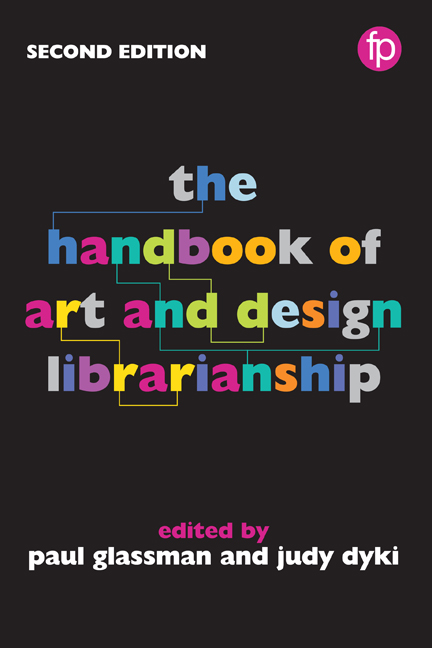Book contents
- Frontmatter
- Contents
- List of figures and tables
- Notes on contributors
- Foreword
- Preface
- Part I Roles and responsibilities
- Part II Materials and collection management
- Part III Teaching and learning
- 14 Embedded in their world: moving mentally into the studio environment
- 15 Teaching with threshold concepts and the ACRL Framework in the art and design context
- 16 Teaching by the book: art history pedagogy and special collections
- 17 Metaliteracy in art and design education: implications for library instruction
- 18 The art of evidence: a method for instructing students in art history research
- 19 ‘I want students to research the idea of red’: using instructional design for teaching information literacy in the fine arts
- 20 Cultural differences and information literacy competencies
- Part IV Knowledge creation
- Part V The physical environment
- Part VI Promotion and sustainability
- Appendix Library profiles
- Index
15 - Teaching with threshold concepts and the ACRL Framework in the art and design context
from Part III - Teaching and learning
Published online by Cambridge University Press: 08 June 2018
- Frontmatter
- Contents
- List of figures and tables
- Notes on contributors
- Foreword
- Preface
- Part I Roles and responsibilities
- Part II Materials and collection management
- Part III Teaching and learning
- 14 Embedded in their world: moving mentally into the studio environment
- 15 Teaching with threshold concepts and the ACRL Framework in the art and design context
- 16 Teaching by the book: art history pedagogy and special collections
- 17 Metaliteracy in art and design education: implications for library instruction
- 18 The art of evidence: a method for instructing students in art history research
- 19 ‘I want students to research the idea of red’: using instructional design for teaching information literacy in the fine arts
- 20 Cultural differences and information literacy competencies
- Part IV Knowledge creation
- Part V The physical environment
- Part VI Promotion and sustainability
- Appendix Library profiles
- Index
Summary
Introduction
Teaching is at the core of the work of many academic librarians, with information literacy as the focus. But how do we define information literacy? And what skills and dispositions constitute information literacy? The way we articulate the definition of information literacy has a direct effect on how we teach it. The Information Literacy Competency Standards for Higher Education (the standards) from the Association of College & Research Libraries (ACRL) set forward a set of common skills and abilities an information literate student possesses. Now the ACRL Framework for Information Literacy for Higher Education (the Framework) posits six ‘big ideas’ or frames that an information literate individual understands (2015a). It represents the culmination of a shifting pedagogical landscape in librarianship. The six frames are intentionally complex and wide ranging in scope. When the frames intersect with research practices within disciplines, they take on different shadings and modulations and are useful in multiple ways. When we apply the Framework from an art and design perspective, what might these ideas look like?
The shifting landscape of information literacy pedagogy
The adoption of the Framework and the rescinding of the standards in 2016 was the result of a sea change in thinking about information literacy. Despite their usefulness, a simple update of the standards could not solve some of their intrinsic issues nor bring them in line with current teaching practices. The standards are essentially a linear progression of many discrete research skills and steps. By overloading learning objectives and giving all components equal priority, no skills were identified as especially crucial (Hofer, Brunetti and Townsend, 2013, 110). Its prescribed order of steps suggested one way to carry out research and one way to understand information literacy; its prescriptive approach models the workflows of often privileged, high-achieving students whose work process most closely aligns with our own as academics and librarians (Elmborg, 2006, 194). Problematically, the
standards do not address the social and political aspects of information, and they present an essentially positivist construction of information – as absolutes separate from context (Foasberg, 2015). The standards position students as mere finders and users of external and discrete units of information, rather than as critical participants in their communities.
- Type
- Chapter
- Information
- The Handbook of Art and Design Librarianship , pp. 147 - 156Publisher: FacetPrint publication year: 2017



